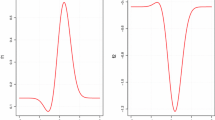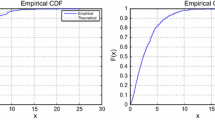Summary
We consider additive models with k smooth terms and correlated errors, and use the penalised spline approach of Eilers & Marx (1996) to estimate the smooth functions. We obtain explicit expressions for the hat-matrix of the model and each individual curve. P-splines are represented as mixed models and REML is used to select the smoothing and correlation parameters. The method is applied to the analysis of some time series data.


Similar content being viewed by others
References
Aerts, M., Claeskens, G. & Wand, M. P. (2002), ‘Some theory for penalized spline generalized linear models’, J. Stat. Plan. Infer. 103, 455–470.
Altman, N. (1990), ‘Kernel smoothing of data with correlated errors’, J. Am. Stat. Assoc. 85, 749–759.
Brumback, B., Ruppert, D. & Wand, M. (1999), ‘Comment on “Variable selection and function estimation in additive nonparametric regression using a data-based prior”’, J. Am. Stat. Assoc. 94, 794–797.
Buja, A., Hastie, T. & Tibshirani, R. (1989), ‘Linear smoothers and additive models (with discussion)’, Ann. Stat. 17, 453–555.
Coull, A., Ruppert, D. & Wand, M. (2001), ‘Simple incorporation of interactions into additive models’, Biometrics 57, 539–545.
Coull, B., Schwartz, J. & Wand, M. (2001), ‘Respiratory health and air pollution: Additive mixed model analyses’, Biostatistics 2, 337–349.
Currie, I. D. & Durban, M. (2002), ‘Flexible smoothing with P-splines: A unified approach’, Statistical Modelling 2, 333–349.
Durban, M. (1999), Modelling Spatial Trend and Local Competition Effects Using Semiparametric Additive Models, PhD thesis, Dept. Actuarial Mathematics and Statistics, Heriot-Watt University, Edinburgh, Scotland, U.K.
Durban, M., Hackett, C. & Currie, I. (1999), ‘Approximate standard errors in semi-parametric additive models’, Biometrics 55, 699–703.
Eilers, P. & Marx, B. (1996), ‘Flexible smoothing with B-splines and penalties’, Stat. Sci. 11, 89–121.
Harris, J. & Liu, L. (1993), ‘Dynamic structural analysis and forecasting of residential electricity consumption’, Int. J. Forec. 2, 437–455.
Hart, J. (1991), ‘Kernel regression estimation with time series errors’, J. Roy. Stat. Soc. B 53, 173–187.
Harville, D. A. (1999), Matrix Algebra from a Statistician’s Perspective, Springer-Verlag.
Hastie, T. & Tibshirani, R. (1987), ‘Generalized additive models: Some applications’, J. Am. Stat. Assoc. 82, 371–386.
Hastie, T. & Tibshirani, R. (1990), Generalized Additive Models, Monographs on Statistics and Applied Probability, Chapman and Hall, London.
Marx, B. & Eilers, P. (1998), ‘Direct generalized additive modeling with penalized likelihood’, Comput. Stat. Data An. 28, 193–209.
Opsomer, J. (2000), ‘Asymptotic properties of backfitting estimators’, J. Multivariate Anal. 73, 166–179.
Opsomer, J. & Ruppert, D. (1999), ‘A root-n consistent backfitting estimator for semiparametric additive modelling’, J. Comput. Graph. Stat. 8, 715–732.
Pinheiro, J. & Bates, D. (2000), Mixed-Effects Models in S and S-PLUS, Statistics and Computing, Springer.
Searle, S., Casella, G. & McCulloch, C. (1992), Variance components, Wiley Series in Probability and Mathematical Statistics.
Smith, M., Wong, C. & Kohn, R. (1998), ‘Additive nonparametric regression with autocorrelated errors’, J. Roy. Stat. Soc. B 60, 311–331.
Verbyla, A., Cullis, B., Kenward, M. & Welham, S. (1999), ‘The analysis of designed experiments and longitudinal data using smoothing splines’, J. Roy. Stat. Soc. C 48, 269–312.
Wang, Y. (1998), ‘Smoothing spline models with correlated errors’, J. Am. Stat. Assoc. 93, 341–348.
Acknowledgements
The authors would like to thank Mike Smith for supplying the electicity data. The work of Maria Durbán was supported by European Commission project IIPCF CT — 2000 — 00041 and by DGES project BEC 2001-1270.
Author information
Authors and Affiliations
Appendices
Appendix A
We derive expression (12) for the hat-matrix in the additive model (9) with k terms. First we define \({\boldsymbol{B}}_{ - i}^* = \left( {{\boldsymbol{B}}_1^*: \ldots :{\boldsymbol{B}}_{i - 1}^*:{\boldsymbol{B}}_{i + 1}^*: \ldots :{\boldsymbol{B}}_k^*} \right)\)and \({{\boldsymbol{a}}_{ - i}} = \left( {{\boldsymbol{a}}_1^\prime , \ldots ,{\boldsymbol{a}}_{i - 1}^\prime ,{\boldsymbol{a}}_{i + 1}^\prime , \ldots ,{\boldsymbol{a}}_k^\prime } \right)\prime \). We rewrite (9) as
and obtain \({\boldsymbol{\hat a}}\) by minimising
Taking derivatives with respect to the components of a we obtain
Equation (17) yields \(\hat \alpha = {\left( {1\prime 1} \right)^{ - 1}}1\prime {\boldsymbol{y}} = {\boldsymbol{\bar y}}\). From (18) we obtain
and so
where
is the centred smoother matrix from the model with the single smooth term \({\boldsymbol{B}}_i^*\). Here A− represents a generalised inverse of A (although the generalised inverse is not unique, \({\boldsymbol{S}}_i^*\) is invariant to the choice of the generalised inverse; (see for example Harville 1999, chap. 9). Substitution of (20) in (19) yields
from which we find
where
and \({\boldsymbol{H}}_{ - i}^*\) is the centred hat-matrix of a weighted additive model (with weights \(\left. {\left( {{\boldsymbol{I}} - {\boldsymbol{S}}_i^*} \right)} \right)\). Thus, \({\boldsymbol{\hat y}} = 1\hat \alpha + {\boldsymbol{B}}_i^*{{\boldsymbol{\hat a}}_i} + {\boldsymbol{B}}_{ - i}^*{{\boldsymbol{\hat a}}_{ - i}} = {{\boldsymbol{H}}_k}{\boldsymbol{y}}\) where
is the hat-matrix for an additive model with k terms, as required.
When \({\boldsymbol{\epsilon }} \sim {\cal N}\left( {0,{\sigma ^2}{\boldsymbol{V}}} \right)\), it is straightforward to show that (13) becomes
where
Appendix B
The additive P-spline setup chooses a for given λ to minimise
with \({\boldsymbol{B}} = \left( {1:{\boldsymbol{B}}_1^*: \ldots :{\boldsymbol{B}}_k^*} \right)\) and P = blockdiag(0, P1,…, Pk) where \({{\boldsymbol{P}}_j} = {\lambda _j}{\boldsymbol{D}}_j^\prime {{\boldsymbol{D}}_j}\). The value of a that minimises (24) satisfies
We show that (25) is the result of estimation in a mixed model. We write \({\boldsymbol{Ba}} = {\boldsymbol{B\tilde G\beta }} + {{\boldsymbol{B}}^*}{\boldsymbol{Zu}}\) with \({\boldsymbol{\tilde G}} = {\rm{blockdiag}}\left( {1,{\boldsymbol{G}}} \right),\;{{\boldsymbol{B}}^*} = \left( {{\boldsymbol{B}}_1^*: \ldots :{\boldsymbol{B}}_k^*} \right)\) and G and Z defined as follows: G = blockdiag(1, G1,…, Gk) where Gi = \(\left( {{{\boldsymbol{g}}_i},{\boldsymbol{g}}_i^2, \ldots ,{\boldsymbol{g}}_i^{{q_i} - 1}} \right)\), qi is the order of penalty for the ith regressor xi and \({\boldsymbol{g}}_i^\prime = \left( {1,2, \ldots ,{p_i}} \right)\) where pi is the rank of Bi; Z = blockdiag(Z1,…, Zk) with \({{\boldsymbol{Z}}_i} = {\boldsymbol{D}}_i^\prime {\left( {{{\boldsymbol{D}}_i}{\boldsymbol{D}}_i^\prime } \right)^{ - 1}}\). Substituting \({\boldsymbol{Ba}} = {\boldsymbol{B\tilde G\beta }} + {{\boldsymbol{B}}^{\boldsymbol{*}}}{\boldsymbol{Zu}}\), in (25) and using DiGi = 0 we find
with P* =blockdiag(P1,…,Pk). Multiplying (26) by \({\boldsymbol{\tilde G}}\prime \) gives
(again using DiGi = 0) while multiplying (26) by blockdiag(0, Z′) gives
Let ri = ndxi + bdegi − pordi be the number of columns of Di, the difference matrix for the ith regressor xi. Then Z′ P* Z = blockdiag(λ1Ir1,…, λkIrk) = Λ. Then (27) and (28) can be written
Thus, \(\hat \beta \) and \(\hat u\) are estimates that arise from the mixed model
where \(u\sim{\cal N}\left( {0,\sigma _u^2} \right),\epsilon \sim{\cal N}\left( {0,{\sigma ^2}V} \right){\rm{ and }}\sigma _u^2 = {\sigma ^2}{{\rm{\Lambda }}^{ - 1}}\)
Rights and permissions
About this article
Cite this article
Durbán, M., Currie, I.D. A note on P-spline additive models with correlated errors. Computational Statistics 18, 251–262 (2003). https://doi.org/10.1007/s001800300143
Published:
Issue Date:
DOI: https://doi.org/10.1007/s001800300143




